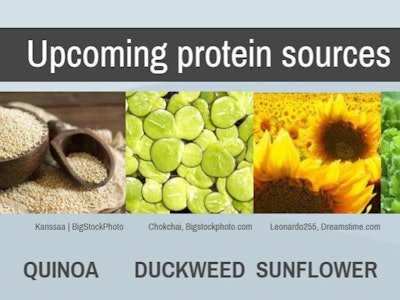
As Earth’s human and pet populations grow, so too does the demand for protein. To meet that demand, plant-based proteins may become increasingly important sustainable pet food protein sources, according to Fred van de Velde, PhD, expertise group leader in protein functionality for NIZO Food Research BV, speaking at Petfood Forum 2017.
Established and emerging plant-based protein sources
Many plant-based proteins have been widely used in human and animal nutrition for years, said van de Velde, such as soybeans, peas, lupin beans, potatoes, wheat and corn. Others are just now starting to become popular and widely available.
Van de Velde defined these emerging plant-based proteins as ingredients that are less used on the market and slowly being adopted, or they are still largely in the research stage. He said emerging crops include fava beans, chickpeas, lentils, marrowfat peas, beans and rapeseed.
Plant-based protein sustainability
When considering upcoming plant-based protein in pet food, it’s important to consider the sustainability of the product in the long term, said Van de Velde. Beyond environmental sustainability, a pet food manufacturer must be able to assure a continued availability of the product as it rises in importance in the food supply.
Van de Velde mentioned whey protein, a cheese production byproduct, as an example of how popularity can reduce availability. Once largely discarded, whey protein is now a key ingredient in infant formula and sport supplements. Competition from human demands reduces the supply available for pet food and animal feed. Similar trends are playing out with soy press cake, potato proteins, grass and beet leaves, and brewer’s spent grains – all byproducts now used as plant-based proteins.
People often think of sustainability in the sense that plant-based proteins use less land, water and energy to produce than animal proteins. However, there are other aspects. The locality of the source – meaning how close it can be produced to where it’s consumed – and the growing season as well as the protein output per hectare of land influence sustainability as well.
Upcoming plant-based proteins
Some upcoming novel pet food ingredients that may meet these sustainability criteria are quinoa, duckweed, sunflower seeds, green leaves and microalgae.
In particular, two emerging protein sources are particularly interesting: duckweed, simple aquatic plants of the subfamily Lemnoideae, and algae. Van de Velde said both protein sources are interesting because they can be grown on water and year-round in the right climates. Because of their habitat, both can thrive in areas that cannot grow other crops and, therefore, they will not compete for land with other agricultural activities.
Pet food protein from duckweed carries a higher amino acid concentration than other plant proteins and is comparable to animal proteins including fishmeal in terms of protein content. Cultivated duckweed can provide more than 20 metric tons of yield on a single hectare of land – 5 tons of which are protein – in a year. Soy yields only 3 tons. The disadvantage of duckweed is that it cannot be grown year round in cooler climates.
Algae could work as alternative protein sources for similar reasons to duckweed, said Van de Velde. A single hectare of algae can produce more than 40 tons of protein. However, the cell walls of algal species are more durable than other plants, so more processing is needed to collect protein, and again, the proper environment is needed for year-round production.
Peas and legumes as protein sources
Pulses – grain seeds of legumes, including dried beans, dried peas, chickpeas and lentils – are appealing because of their relatively high protein content and ability to be grown in a variety of climates, Van de Velde said.
Pulses also have greater levels of lysine, an essential amino acid humans must obtain from their diet, than soy. Protein output from different species varies, but the highest output from red lentils and fava beans is greater than 100 kilograms of protein for each ton of seed processed. Pulses can also be used to create a natural coloring ranging from green to red.
Specifically in pet food, pulse protein isolates can be used to create cat milk, due to its emulsifying properties, lack of lactose and heat stability; both dry and soft kibbles, due to its high protein content; and dental sticks and chew bones, due to its high protein content and lack of starch.
Insects as pet food protein
Although they aren't plant-based, the protein from insects has many of the same sustainability advantages. Van de Velde included insects in a slide from his presentation. Insects can provide low-fat, high-protein ingredients for pet foods, while using less resources than other animals. Fly larvae or mealworms, for instance, are easy to breed and can be fed with organic waste. They are more efficient at converting feed into protein than other animals and require little space to cultivate.
A few pet food companies have begun using insects. For example, Jonker Petfood BV, a private label petfood manufacturer based in the Netherlands, offers dog food with insects as the only animal source of protein.
Earlier this year, Bühler, a pet food and feed industry supplier, and Protix, an insect production company, founded Bühler Insect Technology Solutions, which will develop scalable, industrial solutions for the rearing and processing of insects to provide novel protein sources for livestock, human and pet food. Bühler Insect Technology Solutions is located in China and has already begun operations.















